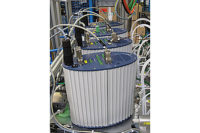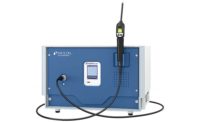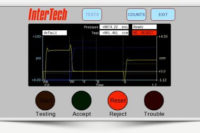Selecting the right leak detector for a particular application can be confusing. Although there are many leak detection technologies, when the leak rate requirement is between 10-6 and 10-10 atm.cc/sec (cubic centimeters of gas per second at a pressure differential of one standard atmosphere), tracer gas methods are the only technologies that deliver accurate and repeatable results. Furthermore, if the leak rate is between 10-6 and 10-10 atm.cc/sec, helium leak detection is the only option.
This article will cover the critical parameters that will help in selecting and implementing helium leak detectors. The article will cover what is commonly called the helium hard-vacuum method. This method can be implemented using an inside-out approach (measuring helium leaking from the test part) or an outside-in approach (measuring helium leaking into the test part).
To better understand how to select a leak detector, let’s first review the leak test process itself. A helium leak test cycle can be broken down into two phases: the pump down step and the helium measurement step.
Pump down time is the time required to achieve a specific vacuum level either inside the part (for an in-leakage test) or inside a test chamber where a pressurized part is placed (for an out-leakage test). The pump down phase can be performed by a wet or dry vacuum pump. First, either the part or the test chamber is evacuated by the pump. Once the desired test pressure is reached, the leak test can be performed. The amount of helium leaking in or out of the part is then measured by the leak detector and displayed on an operator interface.
Pump Down Time
When a part is connected at the inlet of a leak detector, the vacuum pump (often called a roughing pump) will evacuate the part until it reaches a vacuum level that allows the instrument to operate in gross test mode. This vacuum level is called the inlet test pressure. The formula in figure 2 shows that the higher the speed of the roughing pump, the faster it will achieve a specific vacuum level.
Leak detectors typically have several test modes: gross, medium and fine. Most of the time, the gross leak test port is connected at the exhaust of the vacuum pump. The maximum inlet test pressure for gross leak mode typically varies from 1 to 25 millibars (mbar), depending on the model. A pressure of 25 mbar would be the best-case scenario. The formula in figure 3 demonstrates that the higher the maximum inlet test pressure, the faster a gross leak can be performed.
In many cases, it is not possible to place the part directly at the inlet of the leak detector. A vacuum line is then used to connect the two. It’s important to note that pump down time can be affected by the vacuum line. The ability of a vacuum line to allow gas to flow through it is called conductance. The larger the conductance, the faster the gas transfers from the part or test chamber to the leak detector. Thus, it’s important to use the right size vacuum line.
In fluid dynamics, there are four gas flow regimes. For simplicity, we will only focus on two of them: the viscous and the molecular regimes. The viscous regime is encountered during the pump down phase, while the molecular regime is usually met when the leak detector is in fine test mode.
The flow regime inside the vacuum line normally transitions from viscous to molecular during a complete leak test cycle, when going from atmospheric pressure down to 10-3 mbar (or lower). Figures 4 and 5 show the corresponding formulas for conductance in both regimes.
The impact of conductance will be much greater in the molecular regime than the viscous regime, so great care should be given when selecting the vacuum line. Conductance for air and helium in the molecular regime can be easily calculated, since they only depend on the physical dimensions of the vacuum line.
Response Time
The response time of a leak detector is the time it takes to sense a helium signal and measure 63 percent of the total leak rate value. A leak detector’s response time is often confused with its electronic response time. There could be a significant difference between the two. Usually the electronic response time is very short—0.5 to 1 second. The response time can be much greater, depending on pumping speed, the size of the test volume under vacuum, and the conductance of the vacuum line.
Figure 6 shows an equation for calculating the response time of a helium leak detector without an auxiliary pump. The detector’s response time to a helium signal depends on the helium pumping speed (S) and the internal volume of the part (V).
Most of the time, the volume is dictated by the application (the internal size of the part or the dead volume of the test chamber). Although test volume can be reduced by using inserts, it can still be significantly high. As a general rule, the smaller the volume, the faster the cycle time.
The helium conductance of the line connecting the leak detector to the test part can significantly affect response time (figure 7).
Although a leak detector has a specific helium pumping speed at its inlet, its response time will depend on the available pumping speed at the inlet of the part or test chamber. Thus, it’s critical to select the right vacuum line.
The effective pumping speed (ScHe) of a leak detector can be calculated with the following equation, in which CHe is the conductance of the vacuum line and SHe is the base pumping speed of the unit:
(CHe x SHe) / (CHe + SHe) = ScHe
To illustrate the importance of the vacuum line, let’s compare two vacuum lines. Both are 3 feet long, but one has a 0.25 inch ID (CHe of 0.095 liter per second) and the other has a 1 inch ID (CHe of 6 liters per second). The leak detector’s base pumping speed is 2.5 liters per second. Thus, the effective helium pumping speed at the end of each line can be calculated as follows:
(0.095 x 2.5) / (0.095 + 2.5) = 0.091 liter per second
(6 x 2.5) / (6 + 2.5) = 1.76 liters per second
These calculations clearly show the huge impact on helium pumping speed when the wrong vacuum line is used. With a 0.25-inch line, the effective helium pumping speed is only 0.091 liter per second. Such a slow rate would adversely affect the leak detector’s performance, significantly increasing response time and slowing down the total test cycle.
The 1-inch line is a much better choice, although there is still a drop of about 25 percent in helium pumping speed. As a general rule, always use a vacuum line that matches the size of the leak detector inlet flange, and use the shortest length possible.
The faster the pump down time and the helium signal response from the leak detector, the shorter the cycle time.
Test Fixtures and Part Handling
Once engineers have chosen the right leak detector, their job is far from over. Implementing the unit requires some thought, as well. Quite often, little attention is given to tooling, part handling, helium management and the test environment. However, these are just as important as the selecting the right instrument for the application. Would you buy a luxury sports car and then drive it on a dirt road? It would be unthinkable!
The right tooling is critical for leak testing any assembly. A well-designed fixture will guarantee proper sealing of the part. It will also prevent issues with background helium. And, it will prevent virtual leaks that could also be a source of background helium. (See figure 8.)
In our experience, vacuum grease is often used excessively to help seal parts on an inadequate fixture. Vacuum grease traps helium, which increases background helium and makes the leak test process slower and more difficult.
Alcohol is another no-no. Alcohol is occasionally used to clean and improve rubber seals. This practice is not recommended, because alcohol vapor can damage some key components in a leak detector.
When designing a chamber to test pressurized parts, its dead volume should be minimized. The smaller the volume, the faster the pump down time and the faster the response time.
Parts should be as clean and dry as possible before being tested. If not, the pump down time will be slowed due to the presence of water vapor, which is difficult to pump out. Water vapor can also condense on the inside walls of the test chamber or the part, making it even more difficult to reach the desired vacuum level. When pulling vacuum inside a part, gas molecules are removed and an energy exchange takes place, causing the temperature of the part to decrease. Depending upon the amount of water present and the speed of the energy exchange, water vapor condensed on the walls of the part may freeze during the pump down and potentially clog small leaks. Ensuring the parts to be tested are dry and clean will reduce this risk.
The handling of the test parts can be critical for some applications. A helium leak detector can measure leaks ranging from very large (0.1 atm.cc/sec) to very small (10-12 atm.cc/sec). Under a pressure differential of one atmosphere, those leak rates are equivalent to a range of hole sizes, from 0.5 to 50 microns in diameter. Handling of the parts is therefore critical, since even a fingerprint could clog a hole just a few microns in diameter.
Helium Management
Although only 2 to 4 percent of total worldwide helium production is used for leak testing, helium supply is often limited and its price has been steadily increasing over the past decade. There are technologies to address this—but that would be a topic for another article!
Nevertheless, proper application of helium during testing will minimize waste, ensure reliable and repeatable results, and help the leak detector function without contamination from background helium. For example, when looking for helium leaking into a part, only a very small amount of helium should be used. For instance, to detect a leak of 1-7 atm.cc/sec, a couple of small bubbles of helium are more than adequate. Spraying more helium is a waste of money and will only increase the amount of background helium the test instrument must deal with.
After each test, the inlet of the leak detector will vent using ambient air “polluted” with helium. This increases the helium concentration in the leak detector and slows down the test cycle. The same can happen when a part is pressurized with helium, and the helium is not properly vented from the test area. Managing the amount of helium in the test area is critical for optimum performance. Other techniques such as venting the leak detector with nitrogen and providing ventilation to the test area can also help address helium background issues.
Leak testing parts as fast as possible with a high level of accuracy and repeatability is every engineer’s wish. Selecting the right leak detector is the first step. Implementing the instrument with a well-designed fixture and good leak testing practices is a critical second step.
ASSEMBLY ONLINE
For more information on leak testing, visit www.assemblymag.com to read these articles:









